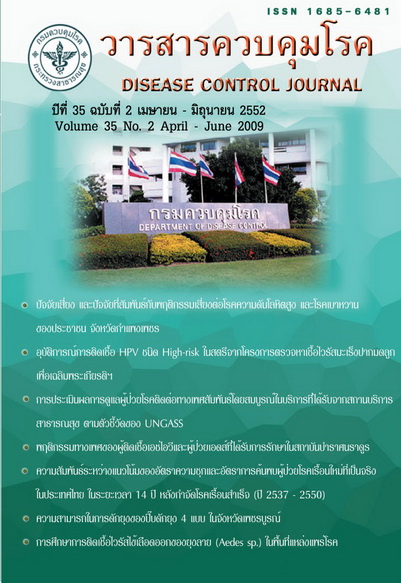Prevalence of HPV-HR Infection among Females in "The programme of Cervical Cancer Screening and Viral test for The Diamond Jubilee, the 60th Anniversary Celebrations of His Majesty the King's Accession to the Throne "
Keywords:
HPV-HR, Prevalence, Risk factor, sexual behaviorAbstract
Human papillomavirus ( HPV ) is thought to be the primary cause of cervical cancer. Early detection of cervical precancerous lesion with Pap smear is the most widely used in prevention method. HPV DNA testing , particular high-risk types, is a promising new technology that benefit to cytology screening programme. An innovation of cervical cancer screening ,using Pap smear plus HPV DNA test, was implemented under the programme named " Cervical cancer screening and viral test for The Diamond Jubilee, the 60th Anniversary Celebrations of His Majesty the King's Accession to the Throne ". The DNA test of high-risk types HPV ( HPV-HR ) was performed by the polymerase chain reaction (PCR) technique and cervical cytology was performed by conventional Pap smear. We enrolled 562 women for the screening procedures between April 2006 to August 2006. High-risk HPV was detected in 107 women ( 19.03 % ). The prevalence of HPV-HR was highest among females aged 26 to 30 years ( 25.23 % ), same as the abnormality of cervical cytology ( 27.27 %). We also found the evidence of more sexual behavior risk exposure in those who had HPV-HR positive ( multiple sex partners, male promiscuous, first sex in the younger age , etc. ).
Downloads
References
2. Bosch FX, Manos MM, Mu?oz N, Sherman M, Jansen AM, Peto J, et al. Prevalence of Human Papillomavirus in Cervical Cancer: a Worldwide Perspective. International Biological Study on Cervical Cancer (IBSCC) Study Group. J Natl Cancer Inst 1995; 87: 796-802.
3. Dunne EF ,Unger ER, Sternberg M, McQuillan G, Swan DC , Patel SS, et al. Prevalence of HPV infection among females in the United States. JAMA 2007; 297(8): 813-9
4. Kulmala SA, Shabalova IP, Petrovitchev N, Syrj?nen KJ, Gyllensten UB, Syrj?nen SM. Prevalence of the most common high- risk HPV genotypes among women in three new independent states of the former Soviet Union. J Med
Virol 2007; 79 (6): 771-781
5. Li LK, Dai M, Clifford GM, Yao WQ, Arslan A, Li N, Shi JF, et al. Human papillomavirus infection in Shenyang City,People's Republic of China: A population-based study. Br J Cancer 2006; 95(11): 1593-7.
6. Sukvirach S, Smith JS, Tunsakul S, Mu?oz N, Kesararat V, Opasatian O,et al. Population- Based Human Papillomavirus Prevalence in Lampang and Songkla, Thailand. J Infects Diss 2003; 187: 1246-1256
7. Herrero R, Hildesheim A, Bratti C, Sherman ME, Hutchinson M, Morales J, et al. Population- Based Study of Human Papillomavirus Infection and Cervical Neoplasia in Rural Costa Rica. J Natl Cancer Inst 2000; 92(6): 464-474
8. Grainge MJ, Seth R, Guo L, Neal KR, Coupland C, Vryenhoef P, et al. Cervical Human Papillomavirus Screening Among Older Women. Emerg Infect Dis 2005; 11(11): 1680-1685
9. Bosch FX, Munoz N, de Sanjose S, Izarzugaza I, Gili M, Viladiu P, et al. Risk factors for cervical cancer in Colombia and Spain. Int J Cancer. 1992 ; 52(5): 750-8.
10. Ishida WS, Singto Y, Kanjanavirojkul N, Chatchawan U, Yuenyao P, Settheetham D, et al. Co-risk factors for HPV infection in Northeastern Thai women with cervical carcinoma. Asian Pac J Cancer Prev 2004; 5(4): 383-6
11. Kliucinskas M, Nadisauskiene RJ, Minkauskiene M. Prevalence and risk factors of HPV infection among high-risk rural and urban Lithuanian women. Gynecol Obstet Invest 2006; 62(3): 173-80
12. Svare EI, Kjaer SK, Worm AM, Osterlind A, Moi H, Christensen RB, et al. Risk factors for HPV infection in women from sexually transmitted disease clinics: comparison between two areas with different cervical cancer incidence. Int J Cancer1998; 75(1): 1-8.
13. Chichareon S, Herrero R, Muoz N, Bosch FX, Jacobs MV, Deacon J, et al. Risk factors for cervical cancer in Thailand: a case-control study. J Natl Cancer Inst 1998; 90: 50-57
14. Ley C, Bauer HM , Reingold A, Schiffman MH, Chambers JC, Tashiro CJ, et al. Determinants of Genital Human Papillomavirus Infection in Young Women. J Natl Cancer Inst 1991; 83(14): 997-1003
15. Castellsagu X, Bosch FX , Muoz N, Meijer CJ, Shah KV. International Agency for Research on Cancer Multicenter Cervical Cancer Study Group. Male Circumcision, Penile Human Papillomavirus Infection, and Cervical Cancer in Female Partners. NEJM 2002; 346: 1105-1112
Downloads
Published
How to Cite
Issue
Section
License
Articles published in the Disease Control Journal are considered as academic work, research or analysis of the personal opinion of the authors, not the opinion of the Thailand Department of Disease Control or editorial team. The authors must be responsible for their articles.


.png)



